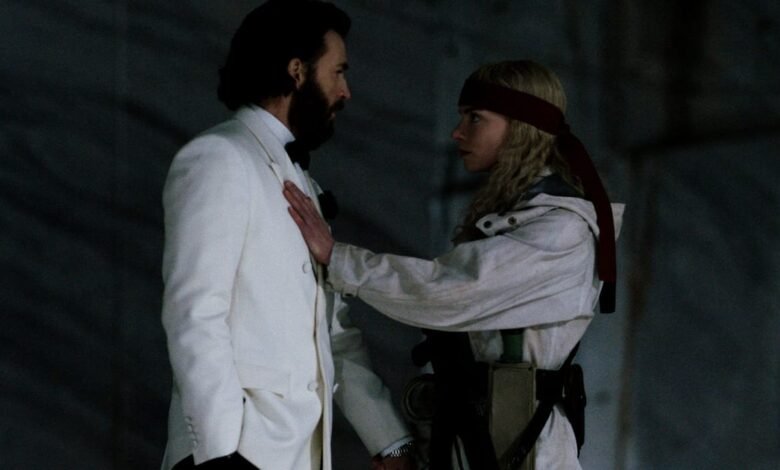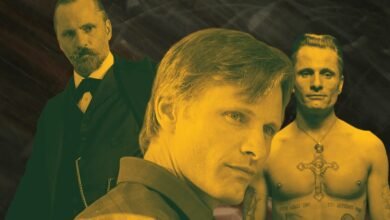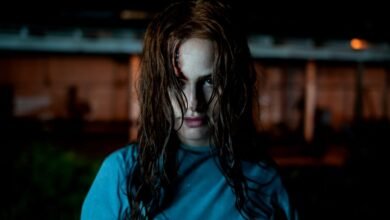

At a Davos-like gathering inside a cavernous marble mine, global elites in dinner dress enjoy a tweezer-precise amuse-bouche and a performance of Cerrone’s all-time Italodisco banger “Supernature” by Charli XCX, when the performance is interrupted by a cadre of pagan eco-warriors led by Anya Taylor-Joy with white Scandi sniper suit, assault rifle, and red headband over Greta Thunberg bangs, striding forward in the strobe light – it’s a radical-chic showpiece you’d expect from the new film by Romain Gavras, who directed the music video for “Bad Girls” for M.I.A. back before the nanoparticles got to her.
Introduced lying on the ground listening to the earth (“Mother,” she says in voiceover, “the volcano spoke to me … the world must burn”), Taylor-Joy’s Joan and her militants arm up and breach the summit by tasing one (1) unarmed security guard. She believes in “the cleansing power of death,” and seeks three human sacrifices to correspond to a witchy but blandly universality cosmology. The Bride, the King, and the Hero will save humanity, by being cast into the raging volcano whose imminent apocalyptic fury is a proxy for climate change. (Surely this messianic splinter cell would want their sacrifice to feed the volcano’s rage and purge the earth of people, rather than pacifying it so business can continue as usual?)
Get more Little White Lies
Raised in Greece by Swedish vulcanologist John Malkovich for co-financing reasons, the amateurish radical militants also include Joan’s brother (Yung Lean, who suggests what the kids from Village of the Damned would have been like on medication) and sister (Jade Croot, who joins the raid wearing LED rabbit ears). They’re there to pick out their sacrifices from the gathered ultrarich, who are there to attend a silent auction benefitting an ocean-mining initiative spearheaded by one of the world’s richest men (Vincent Cassel), who claims to have found a renewable energy source down there, inspired by his pop-star wife (IRL billionairess-by-marriage Salma Hayek Pinault), a lover of pufferfish. “Make Earth Cool Again” says the neon sign behind the step-and-repeat.
Their options include Charli’s Essex-accented backup dancer (Ambika Mod), Chris Evans as Mike Tyler, a Chris Evans-like blockbuster movie star in crisis, and Cassel, who sports a bald Bezos dome, a Steve Jobs turtleneck, and a rather less single-sourced master-of-the-universe arrogance. Half a composite, half a fanciful archetype (why is he holding a charity dinner instead of a financing round? Why is it receiving Met Gala-level media attention?), the characterization is typical of the white-elephant vagueness of Sacrifice — this is a film to make you appreciate that despite the global-English approximateness of Triangle of Sadness, Ruben Östlund really does get a clear sight at his targets. You will also appreciate Östlund more when the gathered masters of the universe greet Taylor-Joy’s entrance with applause, taking it for part of the performance, as if the set piece in The Square depicting the $10,000-a-plate bourgeois punishment ritual had gone straight for the punchline.
The Sacrifice is intermittently farcical, a celebrity-led movie protecting its flashy revolutionary trappings from accusations of hypocrisy by making its characters into the laziest self-deprecating caricatures imaginable: the asshole billionaire, the clumsy zealot, the vain actor. Introduced worrying at his bald spot, repeating the mantra “You’re young, you’re sexy, you have a secret” before plastering on a smile for the cameras, Tyler is deep in an existential funk, having just experienced a viral crashout at a movie première, and questioning his vapid career; he rushes the stage at the fundraiser to decry flashy performative activism in a speech, punctuated by a “do better!” mic drop, quickly labeled “cringe” by Twitter, but sells Joan’s speech to the gathered military and media, and finds a real purpose in Joan’s quest to the heart of the volcano, into which he, the Hero, must leap of his own volition.
The intermittent slapstick of this aging himbo’s conversion to the cause eventually gives way to a puzzling and overwrought earnestness – “What’s my motivation?” is at first a cheap dig at his self-absorption but becomes a serious question, answered by the twin clichés of a love interest and Daddy issues, as limned in an overwrought dream sequence in which he moves through a movie set, egged on by Furiosa fervor and memories of his late father. His hero’s journey, straight out of Joseph Campbell and many screenwriting manuals, is framed as a quest for authenticity, in a movie far too ersatz to have an existence past the moment its cast poses for their last red-carpet photo.




